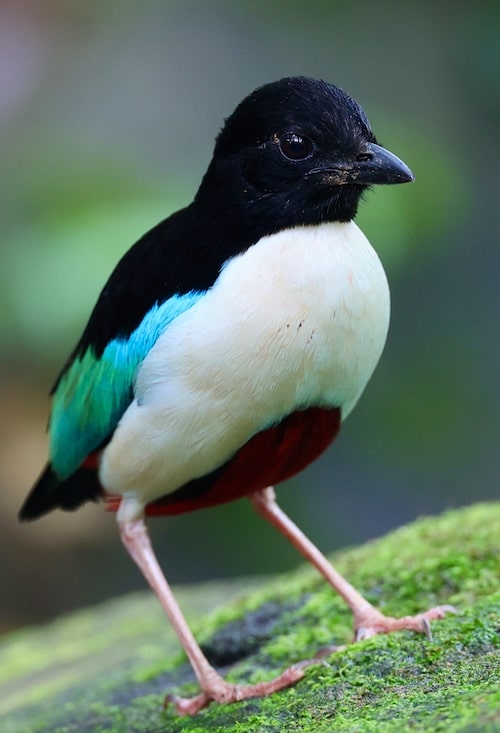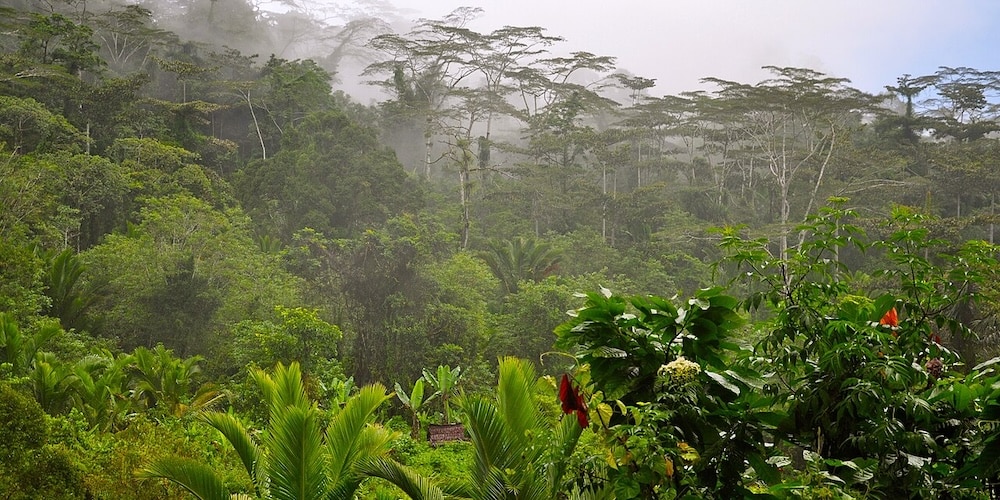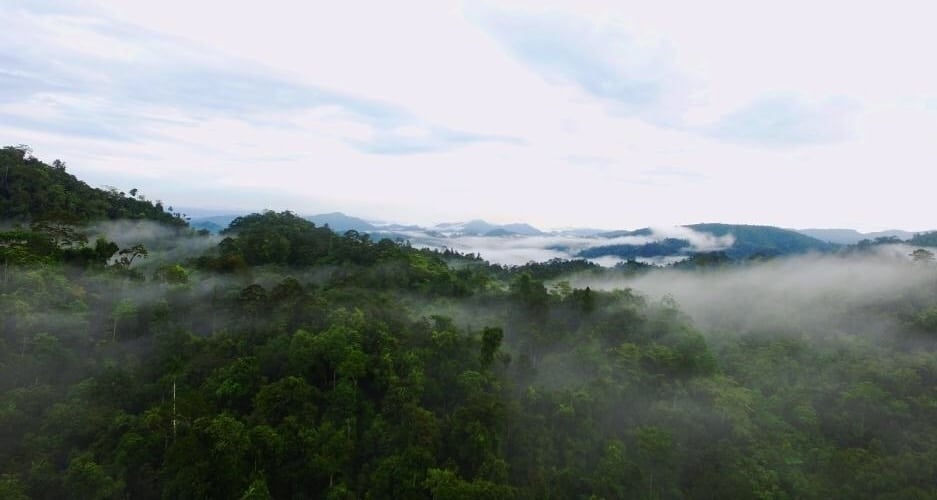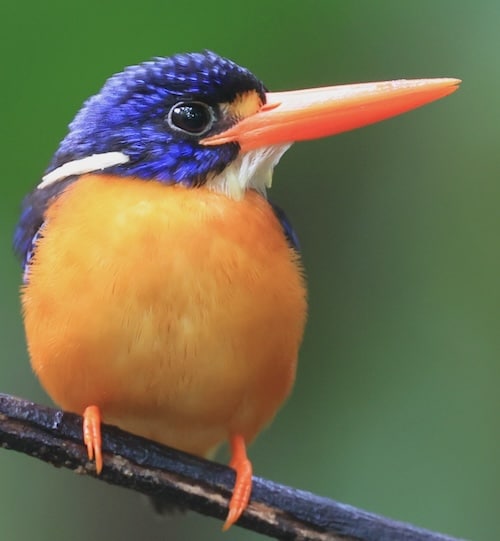Maluku Islands

The Maluku Islands or the Moluccas are an archipelago in the eastern part of Indonesia. Tectonically they are located on the Halmahera Plate within the Molucca Sea Collision Zone. Geographically they are located in West Melanesia. Lying within Wallacea (mostly east of the biogeographical Weber Line), the Moluccas have been considered a geographical and cultural intersection of Asia and Oceania. The islands were known as the Spice Islands because of the nutmeg, mace, and cloves that were exclusively found there, the presence of which sparked European colonial interests in the 16th century. The largest islands are Halmahera, Seram, Buru, Ambon, Ternate, Tidore, Aru Islands, Kai Islands and Lucipara Islands. The whole land area covers nearly 79,000km2 (almost 30,500 square miles), but covers a vast area of ocean of around 850,000 km2. Taken together the population is around 3.2 million people. There are an estimated 1027 islands. The largest two islands, Halmahera and Seram, are sparsely populated, while the most developed, Ambon and Ternate, are small.
The majority of the islands are forested and mountainous. The Tanimbar Islands are dry and hilly, while the Aru Islands are flat and swampy. Mount Binaiya on Seram, at 9,931 feet is the highest mountain. Several islands, such as Ternate and the TNS islands, are volcanoes emerging from the sea with villages sited around their coasts. The Maluku Islands comprise some of the most geologically complex and active regions in the world, resulting from their position at the meeting point of four geological plates and two continental blocks. There have been over 70 serious volcanic eruptions in the last 500 years and earthquakes are common.

Manusela National Park, Seram – ©Fabian Lambeck CC BY-SA 4.0 via Wikimedia Commons
They formed a single province from Indonesian independence, then (1999) they were split into two provinces. A new province, North Maluku, incorporates the area between Morotai and Sula, with the arc of islands from Buru and Seram to Wetar remaining within the existing Maluku Province. North Maluku is predominantly Muslim, and its capital is Sofifi on Halmahera island. Maluku province has a larger Christian population, and its capital is Ambon. Though originally Melanesian, many island populations especially in the Banda Islands, were massacred in the 17th century during the Dutch–Portuguese War, also known as the Spice War. A second influx of immigrants primarily from Java began in the early 20th century under the Dutch and continues in the Indonesian era.

Aketajawe-Lolobata National Park, Halmahera – ©Ministry of Environment and Forestry of Indonesia via Wikimedia Commons
Central and southern Maluku Islands experience the dry monsoon between October and March and the wet monsoon from May to August, which is the reverse of the rest of Indonesia. The dry monsoon’s average maximum temperature is 30 °C while the wet’s average maximum is 23 °C. Northern Maluku has its wet monsoon from December to March in line with the rest of Indonesia. Each island group has its climatic variations, and the larger islands tend to have drier coastal lowlands and their mountainous hinterlands are wetter.
Birding the Moluccas
Biogeographically, all of the islands apart from the Aru group lie in Wallacea, the region between the Sunda Shelf (part of the Asia block), and the Arafura Shelf (part of the Australian block). More specifically, they lie between Weber’s Line and Lydekker’s Line and thus have a fauna that is rather more Australasian than Asian. Malukan biodiversity and its distribution are affected by various tectonic activities; most of the islands are geologically young, being from 1 million to 15 million years old, and have never been attached to the larger landmasses. The Maluku islands differ from other areas in Indonesia; they contain some of the country’s smallest islands, coral island reefs scattered through some of the deepest seas in the world, and no large islands such as Java or Sumatra. Flora and fauna immigration between islands is thus restricted, leading to a high rate of endemism. The ecology of the Maluku Islands has fascinated naturalists for centuries; Alfred Wallace’s book, The Malay Archipelago, was the first significant study of the area’s natural history and remains an important resource for studying Indonesian biodiversity.

Moluccan Dwarf Kingfisher Ceyx Lepidus – ©Bird-Photo-Tours ASIA
Rainforest covered most of northern and central Maluku, which, on the smaller islands has been replaced by plantations, including the region’s endemic cloves and nutmeg. The Tanimbar Islands and other southeastern islands are arid and sparsely vegetated, much like nearby Timor. In recent times the Manusela National Park and the Aketajawe-Lolobata National Park, were established, for the protection of endangered species. Nocturnal marsupials, such as cuscus and bandicoots, make up the majority of the mammal species and introduced mammals include Malayan civets and feral pigs.
Bird species include over 120 endemics with the greatest variety on the large islands of Halmahera and Seram. North Maluku has two species of endemic birds of paradise. Uniquely among the Maluku Islands, the Aru Islands have a purely Papuan fauna including kangaroos, cassowaries, and birds of paradise.
-
Ambon
Satellite ViewThe travel hub of central and southern Maluku. Got a few nice birds too. -
Bacan
Satellite ViewThis is where Wallace first discovered the Standardwing now named after him, but he may also have been the last person that visited this island! -
Buru
Satellite ViewIt looks big on the map, but getting there and getting around is for the adventurous. If you try it the birds are all there somewhere. -
Damar
Satellite ViewThere is an endemic flycatcher here, and who knows what else. -
Halmahera
Satellite ViewPacked with north Moluccan endemics including the stunning Standard wing and Ivory-breasted Pitta. A trip to Halmahera is on many people's wish list. -
Kai
Satellite ViewRelatively easy to get to, nice beaches, two endemic white-eyes and an endemic coucal. Can't say better than that, can you? -
Obi
Satellite ViewIf you make it this far you will be on your own. There is a woodcock here somewhere. Good luck! -
Seram
Huge mountains, obscure islands, Salmon-crested Cockatoo and a whole load more central moluccan specialities and Seram endemics await. -
Taliabu
Satellite ViewIf you can figure out how to get here then there are a load of gripping endemics to be seen! -
Tanimbar
Satellite ViewThe far south of Maluku and not easy to get too. If you make it, the reward is accessible forest packed with endemics.
-
Wikipedia
GNU Free Documentation License
http://en.wikipedia.org/wiki/Maluku_(province) -
Nick Brickle
Burung-Nusantara / Birds-Indonesia | info@burung-nusantara.org
http://burung-nusantara.org
-
Number of bird species: 779
(As at May 2025)
Number of endemics: 123
Tanimbar Megapode Megapodius tenimberensis
Tanimbar Cuckoo-Dove Macropygia timorlaoensis
Sula Fruit-Dove Ptilinopus mangoliensis
Scarlet-breasted Fruit-Dove Ptilinopus bernsteinii
Blue-capped Fruit-Dove Ptilinopus monacha
Gray-headed Fruit-Dove Ptilinopus hyogastrus
Carunculated Fruit-Dove Ptilinopus granulifrons
Spectacled Imperial-Pigeon Ducula perspicillata
Seram Imperial-Pigeon Ducula neglecta
Buru Mountain-Pigeon Gymnophaps mada
Seram Mountain-Pigeon Gymnophaps stalkeri
Goliath Coucal Centropus goliath
Moluccan Brush Cuckoo Cacomantis aeruginosus
Moluccan Owlet-nightjar Aegotheles crinifrons
Seram Swiftlet Aerodramus ceramensis
Moluccan Woodcock Scolopax rochussenii
Moluccan Goshawk Accipiter henicogrammus
Rufous-necked Sparrowhawk Accipiter erythrauchen
Seram Masked-Owl Tyto almae
Taliabu Masked-Owl Tyto nigrobrunnea
Wetar Scops--Owl Otus tempestatis
Sula Scops--Owl Otus sulaensis
Halmahera Boobook Ninox hypogramma
Tanimbar Boobook Ninox forbesi
Seram Boobook Ninox squamipila
Buru Boobook Ninox hantu
Sula Dwarf-Kingfisher Ceyx wallacii
Moluccan Dwarf-Kingfisher Ceyx uropygialis
Seram Dwarf-Kingfisher Ceyx lepidus
Buru Dwarf-Kingfisher Ceyx cajeli
Blue-and-white Kingfisher Todiramphus diops
Lazuli Kingfisher Todiramphus lazuli
Sombre Kingfisher Todiramphus funebris
Azure Roller Eurystomus azureus
Salmon-crested Cockatoo Cacatua moluccensis
White Cockatoo Cacatua alba
Buru Racquet-tail Prioniturus mada
Tanimbar Eclectus Eclectus riedeli
Black-lored Parrot Tanygnathus gramineus
Blue-fronted Lorikeet Charmosyna toxopei
Chattering Lory Lorius garrulus
Purple-naped Lory Lorius domicella
Sula Lorikeet Trichglossus flavoriridis
Red Lory Eos bornea
Blue-eared Lory Eos semilarvata
Sula Hanging-Parrot Loriculus sclateri
Sula Pitta Erythropitta dohertyi
Ivory-breasted Pitta Pitta maxima
Seram Myzomela Myzomela blasii
Crimson-hooded Myzomela Myzomela kuehni
Wakolo Myzomela Myzomela wakoloensis
Red-tinged Myzomela Myzomela rubrotincta
Bacan Myzomela Myzomela batjanensis
Taliabu Myzomela Myzomela wahe
Buru Honeyeater Lichmera deningeri
Seram Honeyeater Lichmera monticola
Black-chested Honeyeater Lichmera notabilis
White-streaked Friarbird Melitograis gilolensis
Tanimbar Friarbird Philemon plumigenis
Buru Friarbird Philemon moluccensis
Seram Friarbird Philemon subcorniculatus
Moluccan Cuckooshrike Coracina atriceps
Buru Cuckooshrike Coracina fortis
White-browed Triller Lalage moesta
Rufous-bellied Triller Lalage aurea
Halmahera Cuckooshrike Celebesia parvula
Pale Cicadabird Edolisoma ceramense
Sula Cicadabird Edolisoma sula
Babar Whistler Pachycephala sharpei
Drab Whistler Pachycephala griseonota
Wetar Oriole Oriolus finschi
Buru Oriole Oriolus bouroensis
Tanimbar Oriole Oriolus decipiens
Seram Oriole Oriolus forsteni
Halmahera Oriole Oriolus phaeochromus
Wetar Figbird Sphecotheres hypoleucus
Taliabu Fantail Rhipidura sulaensis
Tawny-backed Fantail Rhipidura superflua
Streak-breasted Fantail Rhipidura dedemi
Long-tailed Fantail Rhipidura opistherythra
Gilolo Fantail Rhipidura torrida
Tanimbar Monarch Carterornis castus
Boano Monarch Symposiachrus boanensis
Kai Monarch Symposiachrus leucurus
Boru Monarch Symposiachrus loricatus
Moluccan Flycatcher Myiagra galeata
Long-billed Crow Corvus validus
Obi Paradise-crow Lycocorax obiensis
Standardwing Bird-of-Paradise Semioptera wallacii
Golden-bellied Flyrobin Microeca hemixantha
Obi Golden-Bulbul Alophoixus lucasi
Buru Golden-Bulbul Alophoixus mystacalis
Seram Golden-Bulbul Alophoixus affinis
Sula Golden-Bulbul Alophoixus longirostris
Halmahera Golden-Bulbul Alophoixus chloris
Sulawesi Bush Warbler Locustella castanea
Seram Bush Warbler Locustella musculus
Taliabu Bush Warbler Locustella portenta
BuruBush Warbler Locustella disturbans
Gray-hooded Heleia Heleia pinaiae
Rufescent White-eye Tephrozosterops stalkeri
Morotaii White-eye Zosterops dehaani
Kai Besar White-eye Zosterops grayi
Kai Kecil White-eye Zosterops uropygialis
Cream-throated White-eye Zosterops atriceps
Seram White-eye Zosterops stalkeri
Buru White-eye Zosterops buruensis
Ambon White-eye Zosterops kuehni
Buru Jungle-Flycatcher Eumyias additus
Tanimbar Flycatcher Ficedula riedeli
Damar Flycatcher Ficedula henrici
Cinnamon-chested Flycatcher Ficedula buruensis
Fawn-breasted Thrush Zoothera machiki
Buru Thrush Geokichla dumasi
Seram Thrush Geokichla joiceyi
Slaty-backed Thrush Geokichla schistacea
Tanimbar Starling Aplonis crassa
Long-crested Myna Basilornis corythaix
Bare-eyed Myna Streptocitta albertinae
Halmahera Flowerpecker Dicaeum schistaceiceps
Buru Flowerpecker Dicaeum erythrothorax
Ashy Flowerpecker Dicaeum vulneratum
Madanga Madanga ruficollis
-
Avibase
PDF ChecklistThis checklist includes all bird species found in Maluku Islands , based on the best information available at this time. It is based on a wide variety of sources that I collated over many years. I am pleased to offer these checklists as a service to birdwatchers. If you find any error, please do not hesitate to report them. -
E-Bird
PDF ChecklistThis checklist is generated with data from eBird (ebird.org), a global database of bird sightings from birders like you. If you enjoy this checklist, please consider contributing your sightings to eBird. It is 100% free to take part, and your observations will help support birders, researchers, and conservationists worldwide. -
Wikipedia
Annotated ListBirds of the Maluku Islands — an archipelago in Indonesia and the Wallacea ecoregion.
-
A Guide to the Birds of Wallacea
| (Sulawesi, The Moluccas and Lesser Sunda Islands, Indonesia) | By Brian J Coates, K David Bishop & Dana Gardner | Dove Publications | 1997 | Hardback | 535 pages, 64 colour plates [697 species], colour photos, maps, illustrations | Out of Print | ISBN: 9780959025736 Buy this book from NHBS.com -
A Photographic Guide to the Birds of Indonesia
| By Morten Strange | Tuttle Publishing | 2025 | Edition 2 | Paperback | 544 pages, 920 colour photos, colour distribution maps | ISBN: 9780804858397 Buy this book from NHBS.com -
Birds of the Indonesian Archipelago Greater Sundas and Wallacea
| By James A Eaton, Bas van Balen, Nick W Brickle & Frank E Rheindt | Lynx Edicions | 2021 | Edition 2 | Flexibound | 536 pages, 2800+ colour illustrations, 1350 colour distribution maps | ISBN: 9788416728442 Buy this book from NHBS.com -
Birds of the Philippines, Sumatra, Java, Bali, Borneo, Sulawesi, the Lesser Sundas and the Moluccas
| By Norman Arlott | William Collins (Harper Collins imprint) | 2018 | Hardback | 416 pages, 179 plates with colour illustrations; colour distribution maps | ISBN: 9780008102395 Buy this book from NHBS.com
-
MP Aketajawe-Lolobata IBA
InformationSatellite ViewThe park is considered by BirdLife International to be vital for the survival of at least 23 endemic bird species. Aketajawe-Lolobata, which has an area of 167,300 hectares, was declared a national park in 2004. From 243 bird species in North Maluku, 211 have been recorded on Halmahera Island of which 24 are endemic, including Wallace's standardwing, Halmahera cuckooshrike, sombre kingfisher, white cockatoo, invisible rail, blue-and-white kingfisher, dusky-brown oriole, Moluccan goshawk, dusky scrubfowl, long-billed crow, grey-headed fruit dove, ivory-breasted pitta, and azure dollarbird. -
NNR Gunung Sibela
InformationSatellite View -
NP Manusela National Park
InformationSatellite ViewManusela National Park is located on Seram island, in the Maluku archipelago of Indonesia. It is made up of coastal forest, swamp forest, lowland and montane rainforest ecosystem types. Mount Binaiya at 3,027 meters, is the highest of the park's six mountains. Seram is remarkable for its high degree of localised bird endemism. Of the 118 species of bird on the island, 15 are endemic, including the eclectus parrot, purple-naped lory, salmon-crested cockatoo, lazuli kingfisher, sacred kingfisher, grey-necked friarbird, Moluccan king parrot, bicoloured white-eye, black-chinned monarch, and Seram masked owl. -
NR Taliabu
InformationSatellite View
-
Bird Photo Tours ASIA
Tour OperatorBird-Photo-Tours Asia's Central Indonesia journey encompasses both Sulawesi and the Moluccas where we will focus on obtaining close photographic encounters with a variety of endemic Owls / Kingfishers / Nightjars / Birds-of-Paradise. -
BirdQuest
Tour OperatorINDONESIA’S SOUTHERN & CENTRAL MOLUCCAS – Tanimbar, Ambon, Kai, Buru, Seram, Boano, Obi & Bacan -
BirdTour Asia
Tour Operator...much of the Moluccas have rarely attracted birders and it is these we will explore in search of over 100 Moluccan endemics.... -
Birding Ecotours
Tour OperatorBirding Tour Indonesia: Sulawesi and Halmahera – Spectacular Endemic Birding -
Come2Indonesia
Local Tour OperatorYour adventure in the spices island starts here! -
Indonesia Birding Tour
Local Tour OperatorBirding Sulawesi & Halmahera -
Malia Birding
Local Tour OperatorMalia Tour & Travel, established in 2010 by Nurlin Djuni, an esteemed Indonesian tour and birding guide, calls Palu in Central Sulawesi home. -
Minahasa Adventure
Local Tour OperatorMaluku, and Papua stand out as prime destinations for birding tours... -
Rockjumper
Tour OperatorIndonesia - Buru Extension -
Vacation Indonesia Tours
Tour OperatorVacation Indonesia Tours, owned by Nurlin Djuni & Darwin Sumang, is your gateway to Indonesia. We can immerse you in our culture, heritage and our extraordinarily diverse natural history. The Islands of Indonesia are justly famous for birdwatching. Over 372 species have been recorded and many are found nowhere else. Nurlin Djuni specialises in Birdwatching/Holidays Tours in Sulawesi, Halmahera, Papua, Java, Bali, Kalimantan, Lesser Sundas and Sumatera -
Wallacea Bird Tour
Local Tour OperatorThe Moluccas, also known as the Maluku Islands, are an Indonesian archipelago that stands out for its remarkable biodiversity. -
Zoothera Birding
Tour OperatorThe region of Wallacea in Eastern Indonesia is a fascinating archipeligo of rarely visited, isolated islands that all have their own endemics and this tour visits several such islands beginning on Ambon for its sole endemic, Ambon White-eye. Moving on to Kai Kecil & Kai Besar via speedboat for a handful of endemics we will then head to Seram for 4 nights...
-
-
2017 [03 March] - Dave Sargeant - Waigeo to Sulawesi
Report...A good collection of species including several rarely recorded in Singapore, with King Quail, Japanese Sparrowhawk, Slaty-breasted Rail, Red-legged Crake, Sunda Scops Owl, Savanna Nightjar, Blue-throated Bee-eater, Red-crowned Barbet, Long-tailed Parakeet, Greater Painted-snipe, Pin-tailed Snipe, Common Snipe, Asian House Martin and Lanceolated Warbler of particular note..... -
2018 [08 August] - Carlos Bocos
PDF ReportOur annual tour covering the length-and-breadth of the Moluccan islands was a tremendous success once again. The Northern extension, visiting Morotai, Bacan and Obi delivered its full set of recognized ‘field guide’ endemics plus a terrific haul of specialities, like Moluccan Woodcock, Morotai Friarbird, Obi Whistler, Obi Golden Bulbul, Carunculated Fruit Dove, three white-eyes and drongos, Moluccan Drongo Cuckoo, Red-necked Crake, Barking Owl, Pygmy and Gurney’s Eagles and many more. -
2019 [07 July] - James Eaton
PDF ReportThis extensive custom Moluccas tour required six internal flights, six ferries and 10 small boat to visit 12 islands across 20 days. We may have seen just 215 species (and an additional two heard only), but this did include 103 Moluccan endemics! -
2019 [07 July] - James Eaton
PDF ReportThis extensive custom Moluccas tour required six internal flights, six ferries and 10 small boat to visit 12 islands across 20 days. We may have seen just 215 species (and an additional two heard only), but this did include 103 Moluccan endemics! -
2019 [08 August] - Carlos Bocos
PDF ReportDespite the very limited time on the island, Bacan White-eye and Bacan Spangled Drongo showed well, with Variable Dwarf Kingfisher and Red-bellied Pitta adding a splash of color. Obi was good enough to deliver Obi Woodcock on a daily basis, Carunculated Fruit Dove, Obi Whistler, Scarlet- breasted Fruit Dove and Rothschild’s Cuscus, amongst all other possible endemics. -
2020 [09 September] - Andy Walker
PDF ReportThe island of Sulawesi (formerly Celebes) offers some of the best birding in Indonesia, and that’s saying something for a country made up of over 17,500 islands sprawling across 3,181 miles (5,120 kilometers) from east to west, and 1,094 miles (1,760 kilometers) from north to south, including the ‘famous’ islands of New Guinea (Papua and West Papua), Borneo (Kalimantan), Halmahera, Java, Bali, and Sumatra to name a few, and which has a bird list of nearly 1,800 species! -
2022 [07 July] - Andrew Walkwe - Sulawesi and Halmahera
PDF ReportWe recorded 232 species on the tour (nine of these heard only). Some of the birding highlights included Moluccan Megapode, Maleo, White (Umbrella) Cockatoo, Moluccan King Parrot, Golden-mantled Racket-tail, Moluccan Hanging Parrot, Knobbed Hornbill, Sulawesi Hornbill, Blyth’s Hornbill, Goliath Coucal, Sulawesi Hawk-Eagle, Gurney’s Eagle, Pygmy Eagle, Barred (Sulawesi) Honey Buzzard, Sulawesi Masked Owl, Eastern Grass Owl, Ochre-bellied Boobook, Speckled Boobook, Halmahera Boobook, Satanic Nightjar, Scaly-breasted Kingfisher, Green-backed Kingfisher, Sulawesi Lilac Kingfisher, Great-billed Kingfisher, Blue-and-white Kingfisher, Sombre Kingfisher, Common (Halmahera) Paradise Kingfisher, Purple-bearded Bee-eater, Halmahera Paradise-crow, (Wallace’s) Standardwing, Hylocitrea, Malia, Lompobattang Flycatcher, and Lompobattang Leaf Warbler. -
2023 [12 December] - Dáni Balla
PDF ReportIn 2023 we did our best to find the specialties of the following islands: Ambon, Haruku, Seram, Boano, Kai Kecil, Kai Besar with the extension reaching Yamdena (Tanimbars). The number of islands and a well-organized team supporting us, helped us finding an incredible number of endemic and special bird species... -
2024 [08 August] - Anjana
ReportThe islands of Sulawesi and Halmahera are a treasure trove for birders, however, even in 2024, the logistics are complicated and language is a big barrier... -
2024 [11 November] - Susan Myers
ReportThe adventure began in Jakarta before heading east to Ambon, where we boarded a boat to an even smaller island to see the endangered Moluccan Scrubfowl



